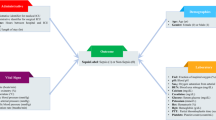Abstract
Early and accurate prediction of sepsis could help physicians with proper treatments and improve patient outcomes. We present a deep learning framework built on a bidirectional long short-term memory (BiLSTM) network model to identify septic patients in the intensive care unit (ICU) settings. The fixed value data padding method serves as an indicator to maintain the missing patterns from the ICU records. The devised masking mechanism allows the BiLSTM model to learn the informative missingness from the time series data with missing values. The developed method can better solve two challenging problems of data length variation and information missingness. The quantitative results demonstrated that our method outperformed the other state-of-the-art algorithms in predicting the onset of sepsis before clinical recognition. This suggested that the deep learning based method could be used to assist physicians for early diagnosis of sepsis in real clinical applications.
This work was partially supported by the National Natural Science Foundation of China (61876197), and the Beijing Municipal Natural Science Foundation (7192105).
Access this chapter
Tax calculation will be finalised at checkout
Purchases are for personal use only
Similar content being viewed by others
References
Yang, M., et al.: Early prediction of sepsis using multi-feature fusion based XGBoost learning and Bayesian optimization. In: The IEEE Conference on Computing in Cardiology (CinC), vol. 46, pp. 1–4 (2019)
Che, Z., Purushotham, S., Cho, K., Sontag, D., Liu, Y.: Recurrent neural networks for multivariate time series with missing values. Sci. Rep. 8, 6085 (2018)
Vicar, T., Novotna, P., Hejc, J., Ronzhina, M., Smisek, R.: Sepsis detection in sparse clinical data using long short-term memory metwork with dice loss. In: The IEEE Conference on Computing in Cardiology (CinC), p. 19381144 (2019)
Reyna, M., et al.: Early prediction of sepsis from clinical data: the physionet/computing in cardiology challenge 2019. Criti. Care Med. 48, 210–217 (2019)
Morrill, J., Kormilitzin, A., Nevado-Holgado, A., Swaminathan, S., Howison, S., Lyons, T.: The signature-based model for early detection of sepsis from electronic health records in the intensive care unit. In: The IEEE Conference on Computing in Cardiology (CinC), p. 19381156 (2019)
Zabihi, M., Kiranyaz, S., Gabbouj, M.: Sepsis prediction in intensive care unit using ensemble of XGboost models. In: The IEEE Conference on Computing in Cardiology (CinC), p. 19425736 (2019)
Chang, Y., et al.: A multi-task imputation and classification neural architecture for early prediction of sepsis from multivariate clinical time series. In: The IEEE Conference on Computing in Cardiology (CinC), p. 19381119 (2019)
Du, J., Sadr, N., Chazal, P.: Automated prediction of sepsis onset using gradient boosted decision trees. In: The IEEE Conference on Computing in Cardiology (CinC), p. 19381157 (2019)
Kreindler, D., Lumsden, C.: The effects of the irregular sample and missing data in time series analysis. Nonlinear Dyn. Psychol. Life Sci. 11, 401–412 (2007)
Che, Z., Purushotham, S., Khemani, R., Liu, Y.: Interpretable deep models for ICU outcome prediction. In: AMIA Annual Symposium, vol. 10, pp. 371–380 (2016)
Kaji, D., et al.: An attention based deep learning model of clinical events in the intensive care unit. PLoS ONE 14, e0211057 (2019)
Rahman, S., et al.: An attention based deep learning model of clinical events in the intensive care unit. J. Biomed. Inf. 58, 198–207 (2015)
Author information
Authors and Affiliations
Corresponding authors
Editor information
Editors and Affiliations
Rights and permissions
Copyright information
© 2020 Springer Nature Switzerland AG
About this paper
Cite this paper
Zhao, R., Wan, T., Li, D., Zhang, Z., Qin, Z. (2020). A Deep Learning Model for Early Prediction of Sepsis from Intensive Care Unit Records. In: Yang, H., Pasupa, K., Leung, A.CS., Kwok, J.T., Chan, J.H., King, I. (eds) Neural Information Processing. ICONIP 2020. Communications in Computer and Information Science, vol 1332. Springer, Cham. https://doi.org/10.1007/978-3-030-63820-7_90
Download citation
DOI: https://doi.org/10.1007/978-3-030-63820-7_90
Published:
Publisher Name: Springer, Cham
Print ISBN: 978-3-030-63819-1
Online ISBN: 978-3-030-63820-7
eBook Packages: Computer ScienceComputer Science (R0)




